Unit 2 Poems 课件2
文档属性
| 名称 | Unit 2 Poems 课件2 | 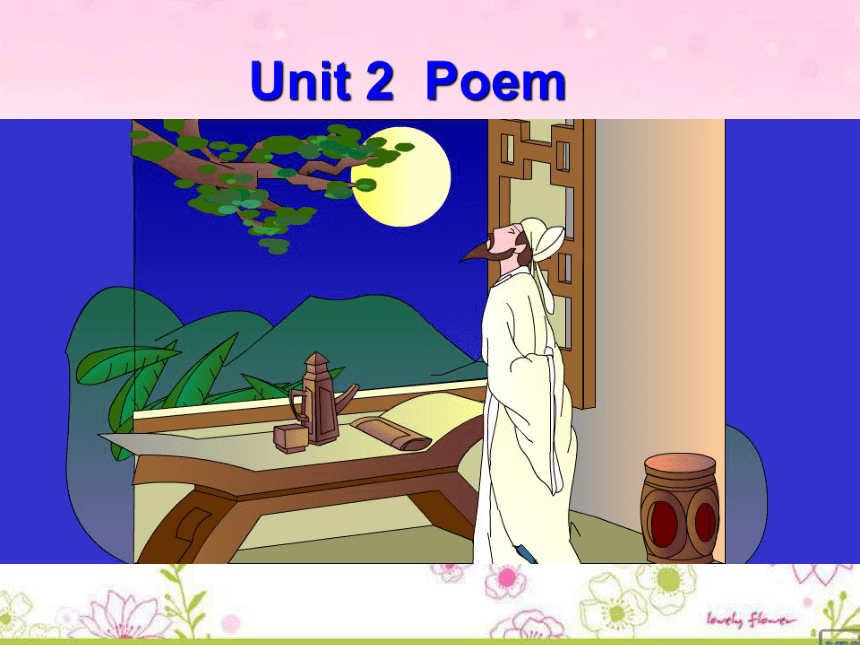 | |
| 格式 | rar | ||
| 文件大小 | 2.5MB | ||
| 资源类型 | 教案 | ||
| 版本资源 | 人教版(新课程标准) | ||
| 科目 | 英语 | ||
| 更新时间 | 2010-08-07 10:08:00 | ||
图片预览

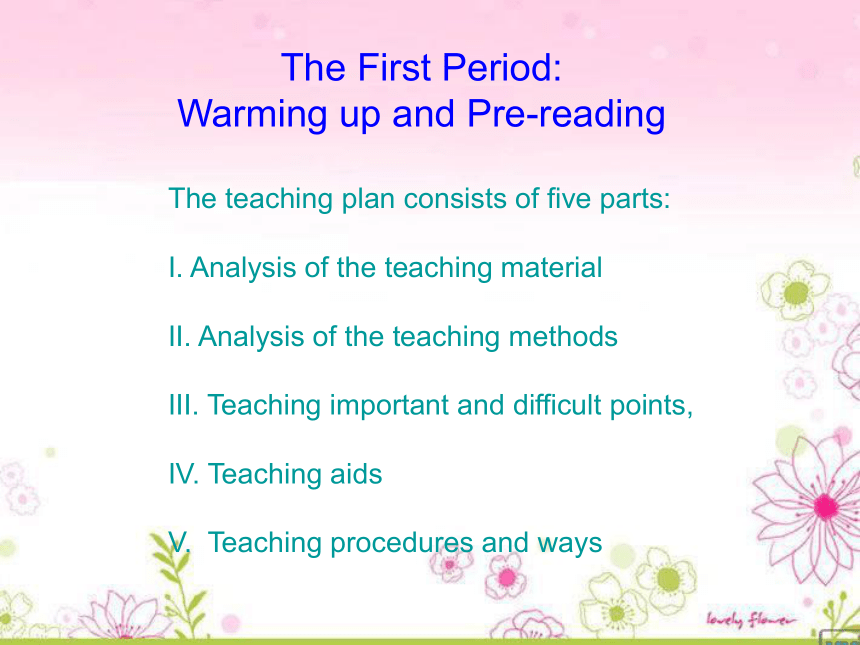
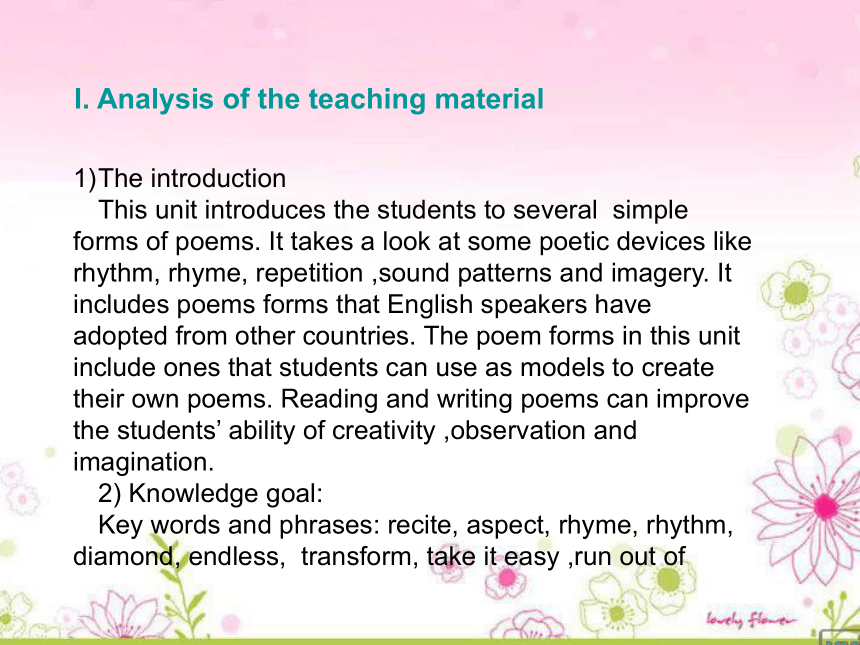
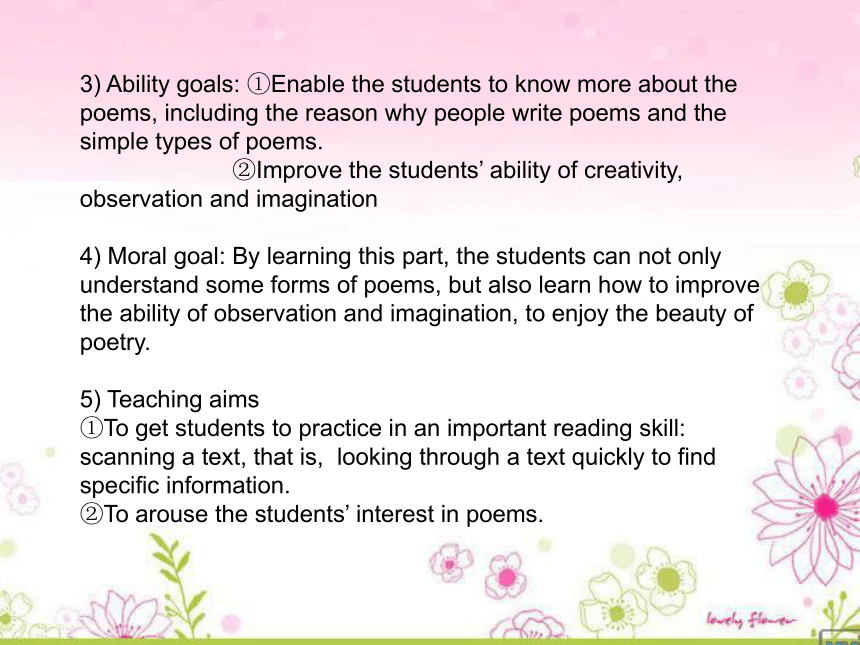
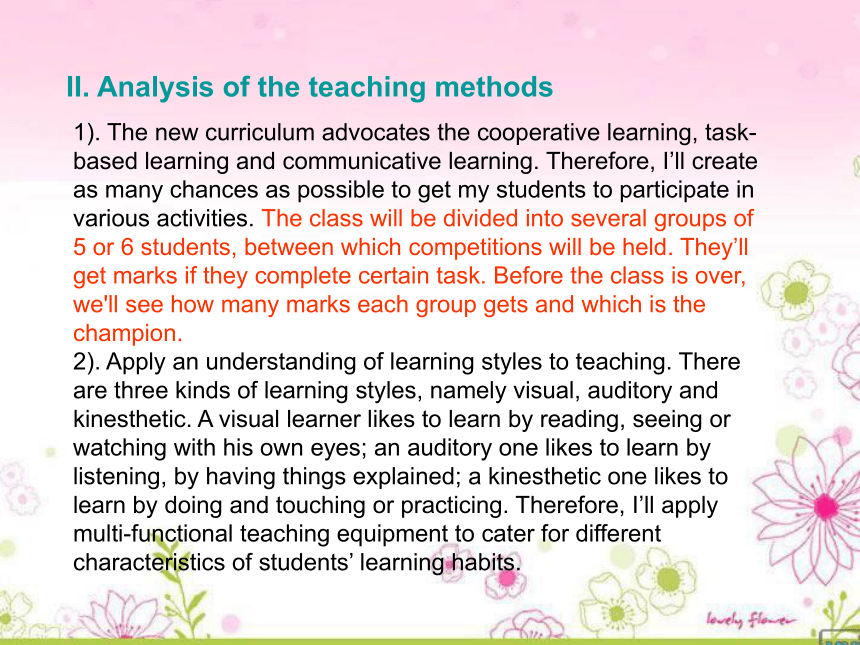
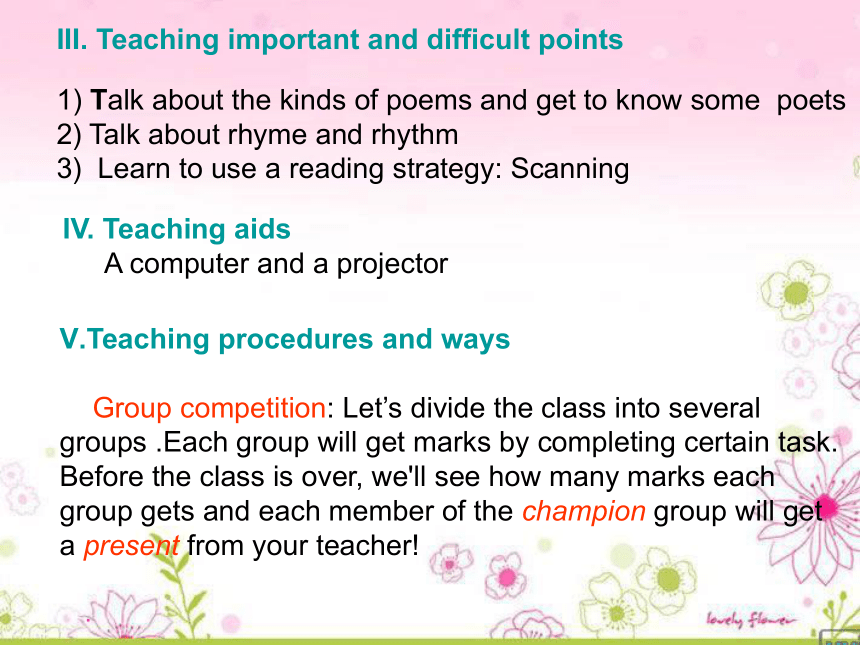
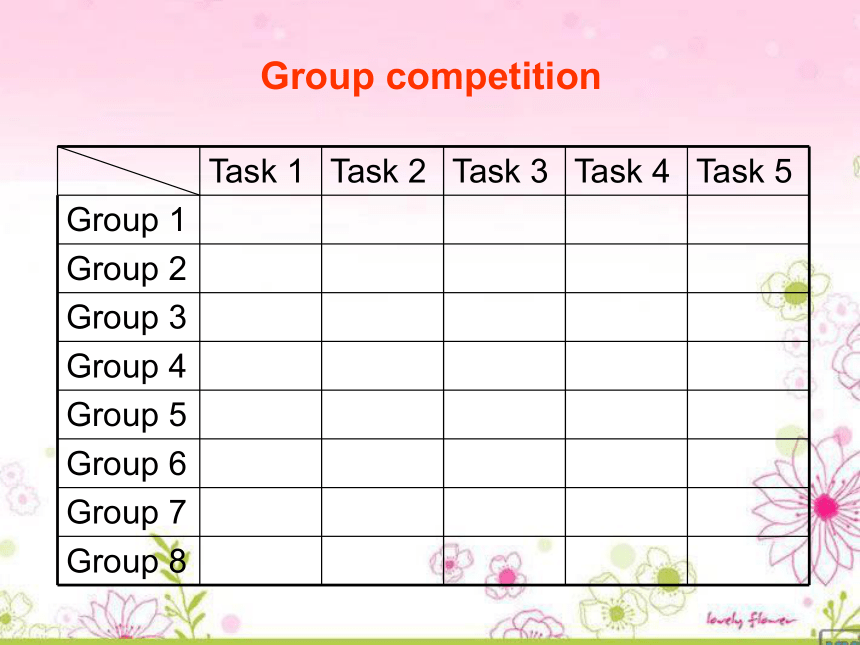
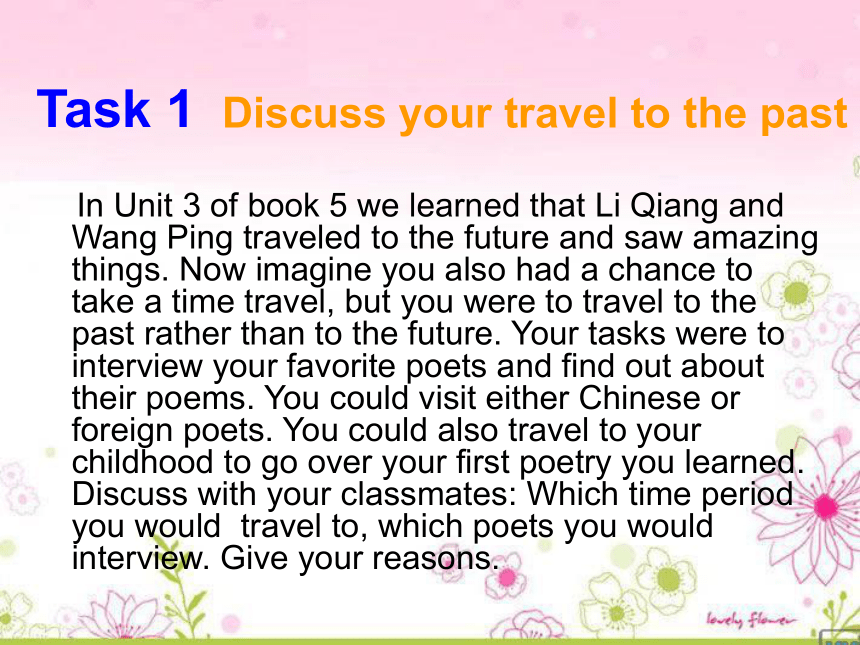
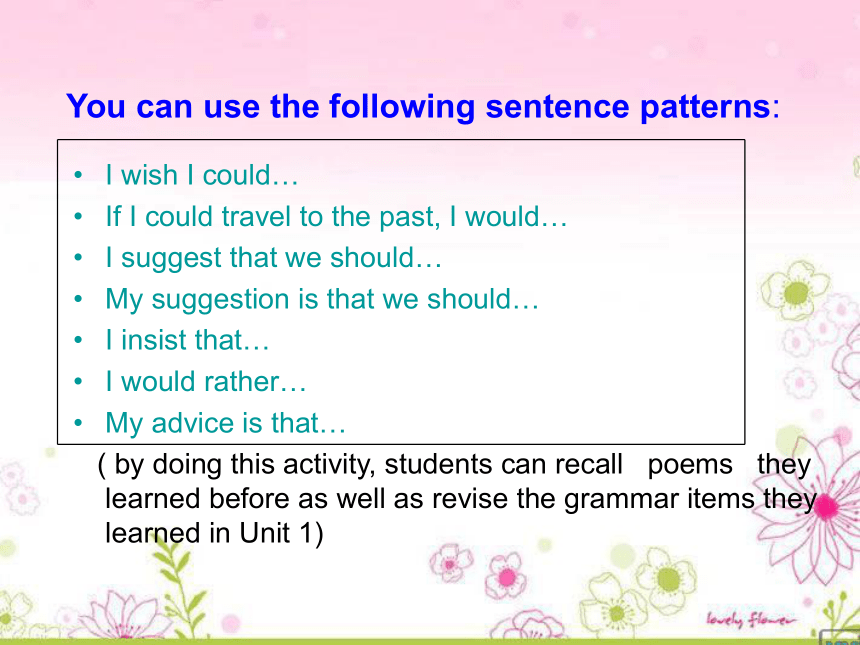
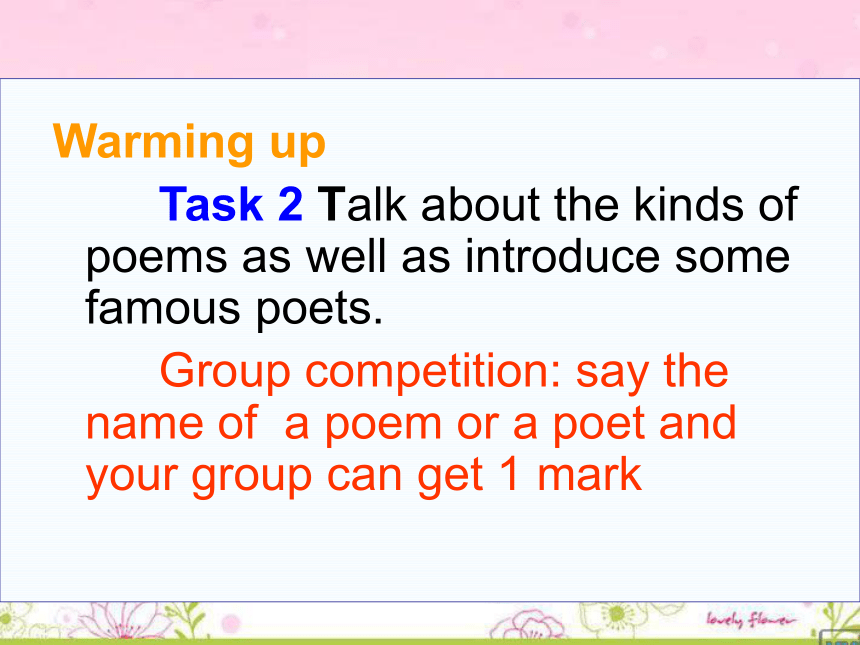
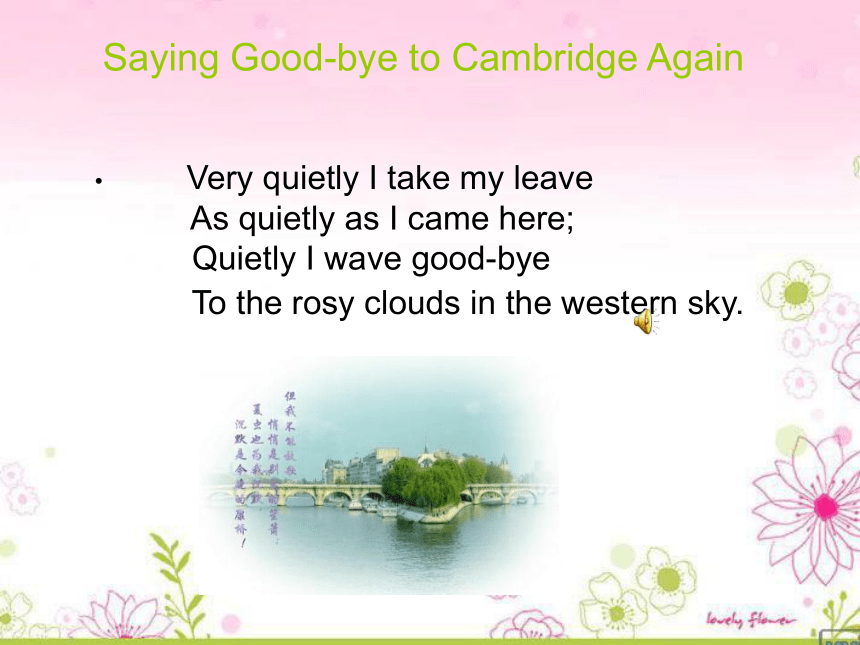
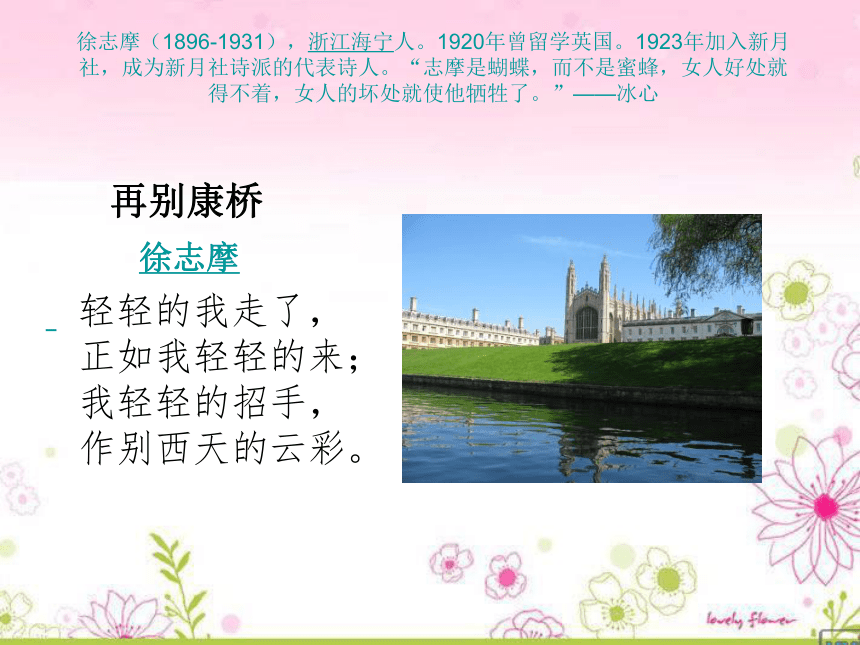
文档简介
课件34张PPT。 Unit 2 PoemThe teaching plan consists of five parts:
I. Analysis of the teaching material
II. Analysis of the teaching methods
III. Teaching important and difficult points,
IV. Teaching aids
V. Teaching procedures and ways
The First Period:
Warming up and Pre-reading
The introduction
This unit introduces the students to several simple forms of poems. It takes a look at some poetic devices like rhythm, rhyme, repetition ,sound patterns and imagery. It includes poems forms that English speakers have adopted from other countries. The poem forms in this unit include ones that students can use as models to create their own poems. Reading and writing poems can improve the students’ ability of creativity ,observation and imagination.
2) Knowledge goal:
Key words and phrases: recite, aspect, rhyme, rhythm, diamond, endless, transform, take it easy ,run out of I. Analysis of the teaching material3) Ability goals: ①Enable the students to know more about the poems, including the reason why people write poems and the simple types of poems.
②Improve the students’ ability of creativity, observation and imagination
4) Moral goal: By learning this part, the students can not only understand some forms of poems, but also learn how to improve the ability of observation and imagination, to enjoy the beauty of poetry.
5) Teaching aims
①To get students to practice in an important reading skill: scanning a text, that is, looking through a text quickly to find specific information.
②To arouse the students’ interest in poems.
1). The new curriculum advocates the cooperative learning, task-based learning and communicative learning. Therefore, I’ll create as many chances as possible to get my students to participate in various activities. The class will be divided into several groups of 5 or 6 students, between which competitions will be held. They’ll get marks if they complete certain task. Before the class is over, we'll see how many marks each group gets and which is the champion.
2). Apply an understanding of learning styles to teaching. There are three kinds of learning styles, namely visual, auditory and kinesthetic. A visual learner likes to learn by reading, seeing or watching with his own eyes; an auditory one likes to learn by listening, by having things explained; a kinesthetic one likes to learn by doing and touching or practicing. Therefore, I’ll apply multi-functional teaching equipment to cater for different characteristics of students’ learning habits.
II. Analysis of the teaching methods
Teaching procedures and ways
Group competition: Let’s divide the class into several groups .Each group will get marks by completing certain task. Before the class is over, we'll see how many marks each group gets and each member of the champion group will get a present from your teacher!
. III. Teaching important and difficult points
1) Talk about the kinds of poems and get to know some poets
2) Talk about rhyme and rhythm
3) Learn to use a reading strategy: Scanning
IV. Teaching aids
A computer and a projector
Group competition Task 1 Discuss your travel to the past In Unit 3 of book 5 we learned that Li Qiang and Wang Ping traveled to the future and saw amazing things. Now imagine you also had a chance to take a time travel, but you were to travel to the past rather than to the future. Your tasks were to interview your favorite poets and find out about their poems. You could visit either Chinese or foreign poets. You could also travel to your childhood to go over your first poetry you learned. Discuss with your classmates: Which time period you would travel to, which poets you would interview. Give your reasons.
You can use the following sentence patterns: I wish I could…
If I could travel to the past, I would…
I suggest that we should…
My suggestion is that we should…
I insist that…
I would rather…
My advice is that…
( by doing this activity, students can recall poems they learned before as well as revise the grammar items they learned in Unit 1)Warming up
Task 2 Talk about the kinds of poems as well as introduce some famous poets.
Group competition: say the name of a poem or a poet and your group can get 1 markSaying Good-bye to Cambridge Again Very quietly I take my leave As quietly as I came here; Quietly I wave good-bye To the rosy clouds in the western sky. 徐志摩(1896-1931),浙江海宁人。1920年曾留学英国。1923年加入新月社,成为新月社诗派的代表诗人。“志摩是蝴蝶,而不是蜜蜂,女人好处就得不着,女人的坏处就使他牺牲了。”——冰心 再别康桥
徐志摩
轻轻的我走了, 正如我轻轻的来; 我轻轻的招手, 作别西天的云彩。 The furthest distance in the world Tagore The furthest distance in the world
Is not between life and death
But when I stand in front of you
Yet you don't know that I love you
世界上最遥远的距离 不是生与死 而是 我就站在你面前 你却不知道我爱你
泰戈尔罗宾德拉纳特·泰戈尔(1861年5月7日—1941年8月7日)是一位印度诗人、哲学家和印度民族主义者,1913年他获得诺贝尔文学奖,是第一位获得诺贝尔文学奖的亚洲人Shakespeare
(1564—1616 ) Shelley
(1792—1822 )The Tang Poems
In the Quiet Night
A bed, I see a silver light,
I wonder if it's frost aground.
Looking up, I find the moon bright;
Bowing, in homesickness I'm drowned.
静夜思 李白
床前明月光,疑是地上霜。
抬头望明月,低头思故乡。
The Willow
The slender tree is dressed in emerald all about,
A thousand branches droop like fringes made of jade.
But do you know by whom these slim leaves are cut out?
The wind of early spring is sharp as scissor blade.
By Meng Haoran
咏柳
碧玉妆成一树高, 万条垂下绿丝绦
不知细叶谁裁出, 二月春风似剪刀
A SPRING MORNING
I awake light-hearted this morning of spring,
Everywhere round me the singing of birds
But now I remember the night, the storm,
And I wonder how many blossoms were broken.
(by Meng Haoran)春晓
春眠不觉晓,处处闻啼鸟.
夜来风雨声,花落知多少. Match the following information:
Du Fu Tang Dynasty
Fan Zhongyan Song Dynasty
Meng Haoran Modern
Xu Zhimo Modern
Mao Zedong Tang Dynasty
Byron America
Shelly England
Emerson England
Tagore Germany
Goethe India TypesfunnyseriousrealismfantasyromanticclassicalmodernSong/Tang DynastyAs we know, poems are mostly written to
show people’s emotions. In Chinese , we
have “ 诗言志,诗言情,诗歌合为事而作.”
That is, people write poems for different
reasons. In small groups make a list of these reasons. Each group can get one point for a reasonable answer.Task 3 Discuss the reasons why people write poems.
The reasons why people write poems.
to tell a story
to express feelings
to make others laugh
to create images in the readers
to express a point of view
to make the reader experience the sight, sounds, smells,
feel and taste of something
to create a mood
to play with words
….
Pre- reading
Task 4.
People from different countries write different kinds of poems. Do you have a favorite poem in Chinese? Why is it your favorite poem? Do you have a favorite poem in English? Why is it your favorite poem?
You can get 1-3 marks for each answer, depending on how good your answer is.
Task 5 Scanning: Please scan the poems on Pages10 & 11.Then fill in the form on Page 9We are going to practice scanning with the reading text. What is scanning? When we want to find particular information, we don’t always have to read every word or every sentence in a text. Instead, we look through a text quickly to find that specific information. In this situation, we don’t have to read the text carefully; it doesn’t matter that we don’t understand every word.Scanning (1 mark for each answer)√√√√√√√√√Scanning: (1 mark for each answer)√√√√√√Group competition Some poetic devices:
1. Rhyme :A rhyme refers
to the repetition of sounds
at the end of rhymed words.
送友人
青山横北郭, 白水绕东城。 此地一为别, 孤蓬万里征。 浮云游子意, 落日故人情。 挥手自兹去, 萧萧班马鸣
Farewell to a FriendBlue mountains bar the northern sky;
White river girds the eastern town.
Here is the place to say goodbye;
You’ll drift like lonely thistledown.
With floating cloud you’ll float away;
Like parting day I’ll part from you.
You wave your hand and go your way;
Your steed still neighs ”Adieu! Adieu!”skygoodbyetownthistledownawaywayyouAdieuRhyme and rhythm are essential to poetry.
Without rhythm, there wouldn’t be poems.2.Rhythm is the beat that runs through the lines in a poem. It is when a stressed syllable is followed by an unstressed syllable so that your voice becomes louder and then softer as you readTwinkle twinkle little star
How I wonder what you are,
Up above the world so high
Like a diamond in the sky. 强 弱 强 弱 强 弱 强构成一个韵节 的四种情况: 强+弱, 强+弱弱,
弱+强, 弱弱+强 Some poetic devices:
1. Rhyme
2. Rhythm
3. Alliteration (头韵) is when the same consonant is repeated.
4.Imagery : create pictures (images) by putting words together in a skillful way.
Poems F, G and HPoem E : summer, sleepy, salty;
drying, drooping, dreading Clerihew---1(打油诗1)
Our art teacher, Mr Shaw, Really knows how to draw. But his awful paintings Have caused many faintings. Clerihew---2(打油诗2)
The enemy of Harry Potter Is a bad plotter. I can't tell you his name Because of his fame. Let's appreciate more Stopping by Woods on a Snowy Evening
by Robert Frost
Whose woods these are I think I know.He gives his harness bells a shake
His house is in the village, though; To ask if there is some mistake.
He will not see me stopping here The only other sound’s the sweep
To watch his woods fill up with snow. Of easy wind and downy flake.
My little horse must think it queer The woods are lovely,dark,and deep,
To stop without a farmhouse near But I have promises to keep,
Between the woods and frozen lake And miles to go before I sleep,
The darkness evening of the year. And miles to go before I sleep.Homework 1. Preview “ A few simple forms of English poems” and enjoy various poetic devices----rhyme, rhythm, alliteration and imagery.
2. Collect at least five English poems and be ready to present them to your classmates in the next class.
I. Analysis of the teaching material
II. Analysis of the teaching methods
III. Teaching important and difficult points,
IV. Teaching aids
V. Teaching procedures and ways
The First Period:
Warming up and Pre-reading
The introduction
This unit introduces the students to several simple forms of poems. It takes a look at some poetic devices like rhythm, rhyme, repetition ,sound patterns and imagery. It includes poems forms that English speakers have adopted from other countries. The poem forms in this unit include ones that students can use as models to create their own poems. Reading and writing poems can improve the students’ ability of creativity ,observation and imagination.
2) Knowledge goal:
Key words and phrases: recite, aspect, rhyme, rhythm, diamond, endless, transform, take it easy ,run out of I. Analysis of the teaching material3) Ability goals: ①Enable the students to know more about the poems, including the reason why people write poems and the simple types of poems.
②Improve the students’ ability of creativity, observation and imagination
4) Moral goal: By learning this part, the students can not only understand some forms of poems, but also learn how to improve the ability of observation and imagination, to enjoy the beauty of poetry.
5) Teaching aims
①To get students to practice in an important reading skill: scanning a text, that is, looking through a text quickly to find specific information.
②To arouse the students’ interest in poems.
1). The new curriculum advocates the cooperative learning, task-based learning and communicative learning. Therefore, I’ll create as many chances as possible to get my students to participate in various activities. The class will be divided into several groups of 5 or 6 students, between which competitions will be held. They’ll get marks if they complete certain task. Before the class is over, we'll see how many marks each group gets and which is the champion.
2). Apply an understanding of learning styles to teaching. There are three kinds of learning styles, namely visual, auditory and kinesthetic. A visual learner likes to learn by reading, seeing or watching with his own eyes; an auditory one likes to learn by listening, by having things explained; a kinesthetic one likes to learn by doing and touching or practicing. Therefore, I’ll apply multi-functional teaching equipment to cater for different characteristics of students’ learning habits.
II. Analysis of the teaching methods
Teaching procedures and ways
Group competition: Let’s divide the class into several groups .Each group will get marks by completing certain task. Before the class is over, we'll see how many marks each group gets and each member of the champion group will get a present from your teacher!
. III. Teaching important and difficult points
1) Talk about the kinds of poems and get to know some poets
2) Talk about rhyme and rhythm
3) Learn to use a reading strategy: Scanning
IV. Teaching aids
A computer and a projector
Group competition Task 1 Discuss your travel to the past In Unit 3 of book 5 we learned that Li Qiang and Wang Ping traveled to the future and saw amazing things. Now imagine you also had a chance to take a time travel, but you were to travel to the past rather than to the future. Your tasks were to interview your favorite poets and find out about their poems. You could visit either Chinese or foreign poets. You could also travel to your childhood to go over your first poetry you learned. Discuss with your classmates: Which time period you would travel to, which poets you would interview. Give your reasons.
You can use the following sentence patterns: I wish I could…
If I could travel to the past, I would…
I suggest that we should…
My suggestion is that we should…
I insist that…
I would rather…
My advice is that…
( by doing this activity, students can recall poems they learned before as well as revise the grammar items they learned in Unit 1)Warming up
Task 2 Talk about the kinds of poems as well as introduce some famous poets.
Group competition: say the name of a poem or a poet and your group can get 1 markSaying Good-bye to Cambridge Again Very quietly I take my leave As quietly as I came here; Quietly I wave good-bye To the rosy clouds in the western sky. 徐志摩(1896-1931),浙江海宁人。1920年曾留学英国。1923年加入新月社,成为新月社诗派的代表诗人。“志摩是蝴蝶,而不是蜜蜂,女人好处就得不着,女人的坏处就使他牺牲了。”——冰心 再别康桥
徐志摩
轻轻的我走了, 正如我轻轻的来; 我轻轻的招手, 作别西天的云彩。 The furthest distance in the world Tagore The furthest distance in the world
Is not between life and death
But when I stand in front of you
Yet you don't know that I love you
世界上最遥远的距离 不是生与死 而是 我就站在你面前 你却不知道我爱你
泰戈尔罗宾德拉纳特·泰戈尔(1861年5月7日—1941年8月7日)是一位印度诗人、哲学家和印度民族主义者,1913年他获得诺贝尔文学奖,是第一位获得诺贝尔文学奖的亚洲人Shakespeare
(1564—1616 ) Shelley
(1792—1822 )The Tang Poems
In the Quiet Night
A bed, I see a silver light,
I wonder if it's frost aground.
Looking up, I find the moon bright;
Bowing, in homesickness I'm drowned.
静夜思 李白
床前明月光,疑是地上霜。
抬头望明月,低头思故乡。
The Willow
The slender tree is dressed in emerald all about,
A thousand branches droop like fringes made of jade.
But do you know by whom these slim leaves are cut out?
The wind of early spring is sharp as scissor blade.
By Meng Haoran
咏柳
碧玉妆成一树高, 万条垂下绿丝绦
不知细叶谁裁出, 二月春风似剪刀
A SPRING MORNING
I awake light-hearted this morning of spring,
Everywhere round me the singing of birds
But now I remember the night, the storm,
And I wonder how many blossoms were broken.
(by Meng Haoran)春晓
春眠不觉晓,处处闻啼鸟.
夜来风雨声,花落知多少. Match the following information:
Du Fu Tang Dynasty
Fan Zhongyan Song Dynasty
Meng Haoran Modern
Xu Zhimo Modern
Mao Zedong Tang Dynasty
Byron America
Shelly England
Emerson England
Tagore Germany
Goethe India TypesfunnyseriousrealismfantasyromanticclassicalmodernSong/Tang DynastyAs we know, poems are mostly written to
show people’s emotions. In Chinese , we
have “ 诗言志,诗言情,诗歌合为事而作.”
That is, people write poems for different
reasons. In small groups make a list of these reasons. Each group can get one point for a reasonable answer.Task 3 Discuss the reasons why people write poems.
The reasons why people write poems.
to tell a story
to express feelings
to make others laugh
to create images in the readers
to express a point of view
to make the reader experience the sight, sounds, smells,
feel and taste of something
to create a mood
to play with words
….
Pre- reading
Task 4.
People from different countries write different kinds of poems. Do you have a favorite poem in Chinese? Why is it your favorite poem? Do you have a favorite poem in English? Why is it your favorite poem?
You can get 1-3 marks for each answer, depending on how good your answer is.
Task 5 Scanning: Please scan the poems on Pages10 & 11.Then fill in the form on Page 9We are going to practice scanning with the reading text. What is scanning? When we want to find particular information, we don’t always have to read every word or every sentence in a text. Instead, we look through a text quickly to find that specific information. In this situation, we don’t have to read the text carefully; it doesn’t matter that we don’t understand every word.Scanning (1 mark for each answer)√√√√√√√√√Scanning: (1 mark for each answer)√√√√√√Group competition Some poetic devices:
1. Rhyme :A rhyme refers
to the repetition of sounds
at the end of rhymed words.
送友人
青山横北郭, 白水绕东城。 此地一为别, 孤蓬万里征。 浮云游子意, 落日故人情。 挥手自兹去, 萧萧班马鸣
Farewell to a FriendBlue mountains bar the northern sky;
White river girds the eastern town.
Here is the place to say goodbye;
You’ll drift like lonely thistledown.
With floating cloud you’ll float away;
Like parting day I’ll part from you.
You wave your hand and go your way;
Your steed still neighs ”Adieu! Adieu!”skygoodbyetownthistledownawaywayyouAdieuRhyme and rhythm are essential to poetry.
Without rhythm, there wouldn’t be poems.2.Rhythm is the beat that runs through the lines in a poem. It is when a stressed syllable is followed by an unstressed syllable so that your voice becomes louder and then softer as you readTwinkle twinkle little star
How I wonder what you are,
Up above the world so high
Like a diamond in the sky. 强 弱 强 弱 强 弱 强构成一个韵节 的四种情况: 强+弱, 强+弱弱,
弱+强, 弱弱+强 Some poetic devices:
1. Rhyme
2. Rhythm
3. Alliteration (头韵) is when the same consonant is repeated.
4.Imagery : create pictures (images) by putting words together in a skillful way.
Poems F, G and HPoem E : summer, sleepy, salty;
drying, drooping, dreading Clerihew---1(打油诗1)
Our art teacher, Mr Shaw, Really knows how to draw. But his awful paintings Have caused many faintings. Clerihew---2(打油诗2)
The enemy of Harry Potter Is a bad plotter. I can't tell you his name Because of his fame. Let's appreciate more Stopping by Woods on a Snowy Evening
by Robert Frost
Whose woods these are I think I know.He gives his harness bells a shake
His house is in the village, though; To ask if there is some mistake.
He will not see me stopping here The only other sound’s the sweep
To watch his woods fill up with snow. Of easy wind and downy flake.
My little horse must think it queer The woods are lovely,dark,and deep,
To stop without a farmhouse near But I have promises to keep,
Between the woods and frozen lake And miles to go before I sleep,
The darkness evening of the year. And miles to go before I sleep.Homework 1. Preview “ A few simple forms of English poems” and enjoy various poetic devices----rhyme, rhythm, alliteration and imagery.
2. Collect at least five English poems and be ready to present them to your classmates in the next class.
